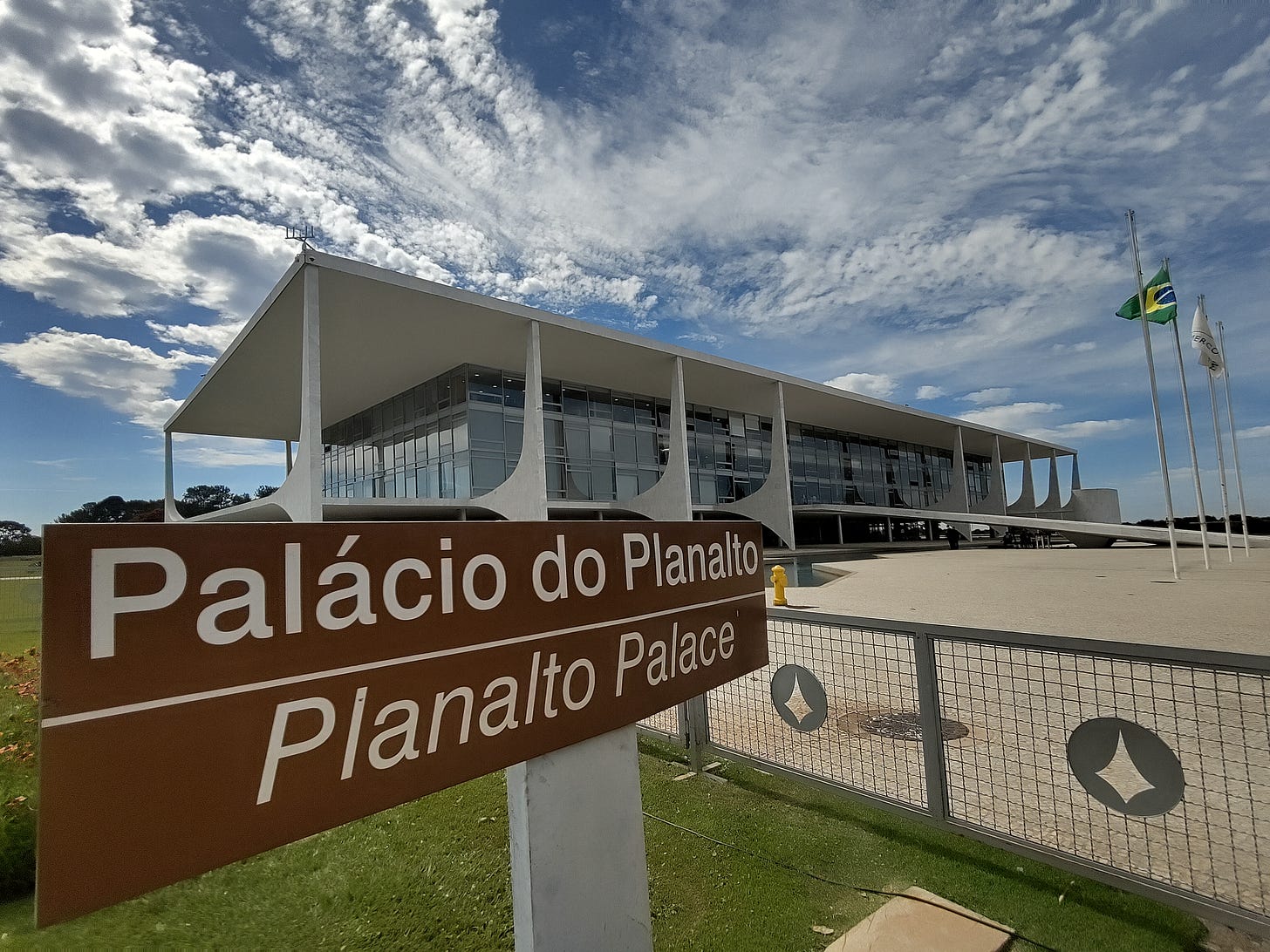Notes From Brasilia (2)
On measurements, benchmarks, & making sure data counts
Last week, during one of the Q&A sessions at the conference in Brasilia, an attendee made a point that is still percolating in my head.
She said when she told her family members about the event and the discussions, one asked, “Is anyone going to discover about this? About the solutions, the innovations? Will the public ever hear about this?”.
Such an obvious question and it made me think, as a communicator and someone who gets to be in these spaces, what more I can do to let people know they can be agents of change and not helpless bystanders?
Thin Ink is one way, albeit a tiny one, and it’s also why I haven’t put up a paywall, because I think this information is too important to be accessible only to those with resources.
I also really like the impact work Lighthouse is doing too, to ensure that our long-term investigations don’t just disappear into the ether once they’re published, but that affected communities are actively informed about the outcomes and possible recourse.
Then I draw a blank. So if you have any ideas, I’m all ears.
I’m continuing with my reflections from Brasilia, but focusing on a single plenary session this time. It was about how we measure progress and promote accountability mechanisms for food systems transformation. You can watch the 90-minute session in full here.
I wanted to write about this session for two reasons:
Data is catnip to journalists and I’m instinctively drawn to anything with numbers, so I think other writers who read Thin Ink would be interested too, and
To share the gaps, challenges, and nuances that the speakers highlighted so we can be better informed and more discerning in future.
Yes, it’s a nerdy topic. But I’m a nerd. So there!
Where We Are…..
I think we all agree that good data is essential to track food systems transformation. It helps us to establish where we are currently, so we can plan what we need to do to get to where we want to be, and to see if we are getting there (or not).
But we also need the data to go beyond the traditional, meaning beyond production and trade volumes and the fluctuations of the commodity markets. We also need detailed, disaggregated statistics on hunger, malnutrition, and what people are eating.
And given that food systems transformation requires good governance - see last week’s issue - there has to be ways to rate and rank policy environments on whether they’re encouraging or hindering the transformation.
The bad news is that there are many challenges to achieving this.
Data is often not integrated.
Ricardo Mota, Strategic Intelligence Manager at Pacto Contra A Fome (Pact Against Hunger), a multi-sector coalition, said when they were trying to find out where food loss and waste was occurring in Brazil, they discovered there was no integrated data.
In order to come up with a strategy to tackle this issue, they ended up having to use data from different sources, he said.
Approaches aren’t systemic.
Currently, different scientific, government, and academic bodies are using too many different methodologies to measure things, said Sergio Schneider, Professor of Sociology of Rural Development and Food Studies at the Federal University of Rio Grande do Sul.
What’s lacking, according to him, is a systemic approach, as policymakers are still too hung up on their specific sectors.
“Platform Cemetery” is a thing.
The lack of integration - and perhaps that systemic view Sergio was talking about above - often results in a “Platform Cemetery” where abandoned projects go to die, said Ricardo.
This isn’t just about resources going to waste, it also means data from these platforms don’t feed into decision-making processes.
Data beyond the farm gate is often “a black box”.
Sometimes though, quality data just isn’t available, like what happens between the produce leaving the farm and reaching the retail space.
In developing countries, small and medium enterprises are doing some of the key work in this middle part of the food value chain but “it’s a black box and we don’t have data, particularly data that’s comparable across countries”, said Stella Nordhagen, Research Lead at the Global Alliance for Improved Nutrition (GAIN).
The good news is that strong approaches to measure these things already exist.
FAOSTAT, from the UN food and agriculture agency FAO, has all the data you’d need on production, some going back to 1961. In recent years it has also started collecting data on populations unable to afford nutritious diets and the hidden costs of our food systems that are not reflected in yields or the prices of food at grocery stores.
But I want to focus on two that were mentioned in the session.
The Food Systems Dashboard from the Food Systems Countdown Initiative
This tremendous effort by a group of researchers, which includes Stella, uses existing data to track food systems transformation around the world through 50 indicators across five themes. It is one solution to the silo-ing of data and methodologies that other speakers spoke of.
The findings showed no country or region is doing very well or very poorly on all indicators, said Stella. For example, Brazil has reduced food insecurity and increased civil society participation and agricultural yields, but pesticide use is still high, as is the consumption of unhealthy foods. But this also means we can learn from each other.
I’ve written about the history of this project and its initial and updated findings (see here and here). The website is very much worth checking out.
Food and Agriculture Benchmark from the World Benchmarking Alliance
This measures, tracks, and rates the performance of 350 biggest companies in the food and agriculture sector across the full spectrum of environmental, social and health issues based exclusively on the companies’ public disclosures, said Alejandro Guarin, Food Systems Transformation Lead at the Alliance.
This is because a relatively small number of big companies have a huge role within the food systems and their willingness - or unwillingness - to change could really move the needle.
Where We Need To Be…..
We need to fill existing gaps.
This includes things like getting high quality post-farm gate data, ensuring that data is integrated and comparable across different countries, and eliminating “platform cemetery”.
In Brazil, Pacto Contra A Fome and partners are working on a project called Hunger Observatory to integrate qualified data and guide civil society.
Also, companies don’t disclose nearly enough data, sometimes hiding behind the different frameworks and compliance mechanisms, said Alejandro. One way to change this is to be precise and surgical in what we want them to disclose, he said.
We need to better understand the underlying drivers and barriers.
We currently measure outcomes but not the processes nor what’s stopping the needed changes from taking place.
If we don’t track the approaches and steps taken, it will be hard to course-correct later, said Stella.
In addition, dimensions like collaboration and power asymmetry are hard to measure and currently no quantitative data or indicators exist, but are crucial to measure and learn from, said Jose Valls from the FAO during the Q&A session.
But change is afoot. Another attendee, James Leslie from UNDP, said UNDP has been working with the Gates Foundation to develop just that. They’re coming up with a practical toolbox for practitioners to monitor transformation across six key areas (mindsets, behaviours, relationships, institutions, resource flows and power dynamics). It should be available in a few months, he said.
We need better messaging.
“I feel we need to really concentrate minds. We need two or three things… not 90 things… that you can really rally behind. Otherwise, we’re going to lose people… When I tell my parents, my friends that I work on food systems, they have no idea what I’m talking about. It’s jargon. If I say I’m working to reduce hunger, everybody knows what I’m talking about.” - Alejandro
“People want happiness. They want to eat good food, for that food to not harm nature, and for that to produce social development. We need another way to translate this complex (food systems) representation in journals and academia. We need another way to talk among scientists and the people that implement policy making.” - Sergio
We need a new mindset.
“We’re still very far from having food policies. What we have is policies to stimulate the supply and increase production,” said Sergio, and this productivist mindset is one reason why we have so much food waste in the world (19% at food service and household levels alone according to latest data).
“We are producing too much, we’re wasting too much, and the food is not going to where it’s needed most. We must develop methodologies to overcome this gap.”
We need to find synergies between industry and society where we can….
Reducing food loss and waste is one area where there’s alignment between the interests of companies and the interests of society, said Alejandro. Both groups want to tackle this, even if it’s for different reasons.
…and look at other levers where we can’t.
However, in some areas,like food labelling, companies and society have completely opposing interests, he said, pointing to an earlier presentation by Yessika Hoyos of Colombia-based lawyers’ collective CAJAR.
“There, the responsibility shifts to the regulator. You need to make sure the companies are doing this (labelling). You need to support Yessikas of the world so they can fight this,” he said.
We need to move from monitoring to accountability.
Having data is “an important step” but is not the same as accountability, said Stella.
One way the Food Systems Countdown Initiative is trying to bring accountability is to publish a report every year until 2030, benchmark where each country is doing in comparison to others, and tie the findings to major global events. They are also working with individual countries to make the benchmarking more comprehensive and tailored.
Often, getting those in power to act based on what the data says requires coordinated and concerted efforts from all those who care, from civil society organisations to grassroots movements. But to do this, people need to be aware of the existence of the data, what it means, and how it works, so they can advocate for themselves as well.
Ricardo said they are now working with state governments in Brazil to learn how to measure and share data with citizens, with the aim of drawing up effective policies.
Thin’s Pickings
The New Geopolitics of Food - IPES-Food Webinar
I moderated a fascinatingly wide-ranging discussion on Tuesday on how trade wars, geopolitical rivalry, conflict, and economic instability are creating - and are likely to create - a new era for food systems, both good and bad. It’s 90 minutes long but the speakers were on point and it’s totally worth it, I swear.
The latest controversies on GWP*
Climate scientists wrote an open letter to New Zealand’s prime minister criticising its plan to adopt a new methane target that will allow rich countries with historically high emissions of methane, a greenhouse gas significantly more potent than carbon dioxide, to continue emitting.
In a LinkedIn post, Paul Behrens, one of the signatories, explain why this is unjust: “if a high-income country keeps emissions at 100 units it meets a "no additional warming target" for methane, while a lower-income country wouldn't for increasing emissions from 0 to 5 units!”
”The higher income country is emitting 20 times more but under such a target it's the lower-income country that is seen as doing more damage”.FT’s Susannah Savage did a story on the letter that gives additional context to GWP* but it’s behind a paywall. But Paul kindly shared it on his LinkedIn post so you can read it there.
Deadly Aid Deliveries in Gaza - The New York Times
What is happening in Gaza, where Israeli authorities are using food as a weapon of war, is unconscionable, as this explainer shows.
“Hungry Palestinians have walked for miles and gathered before dawn at the distribution sites. The crowds have panicked and shoved in the dark for a chance to get one of the limited cardboard boxes of food. Israeli soldiers stationed near the sites have repeatedly opened fire. The circumstances are contested, but the Red Cross reported that at least 27 people were killed yesterday morning (THIN: meaning Tuesday) and at least 21 people were killed in a shooting on Sunday.”
Why competition authorities must address food markets - Shamba Centre for food & climate
This piece highlights some interesting nuggets of anti-competitive behaviour in many parts of the world. But I suspect the examples Carin pointed out are just the tip of the iceberg. I look forward to seeing journalists and experts digging deeper into this issue.Sebastiǎo Salgado’s View of Humanity - The New Yorker
This piece is a fitting tribute to the amazing Brazilian photographer who recently passed away at the age of 81. Some have criticised his photographs for anaesthetising tragedy and being uncritical but I personally found them incredibly moving. I also respect how he took on projects he believed in and breathed a new, more ecologically-friendly life into his family cattle ranch.
As always, please feel free to share this post and send tips and thoughts on bluesky @thinink.bsky.social, mastodon @ThinInk@journa.host, my LinkedIn page, twitter @thinink, or via e-mail thin@thin-ink.net.







